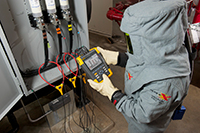view all Case Studies
Power Player: Analyzer Helps Technicians Troubleshoot Electrical System

Stan Benoit is responsible for keeping dozens of complex imaging systems at peak performance for five hospital campuses and 31 satellite facilities for Geisinger Health System in Northeastern and Central Pennsylvania
April 8, 2013 -
Power & Communication
Stan Benoit is responsible for keeping dozens of complex
imaging systems at peak performance for five hospital campuses and 31 satellite
facilities for Geisinger Health System in Northeastern and Central
Pennsylvania.
Downtime is costly, both in terms of patient well-being and the
organization’s finances. The X-ray, mammography, and other systems cost
millions, and a failure involving any of them can idle technicians and surgical
teams. When complex CAT scanners, MRI, and cardiac-catheterization systems
experience problems, the first question is usually, “Is it the electronics, or
is it the power?” followed by, “Whose problem is it?”
Benoit, a certified radiology equipment specialist/radiology
and oncology maintenance supervisor, is a 23-year veteran of medical
electronics, but he was not an expert on power quality. And without hard facts,
he found it difficult to orchestrate the system’s maintenance teams.
After acquiring a Fluke 434 power-quality analyzer, Benoit
started learning more about power quality and was able to do basic tests on
three-phase power and share the resulting data with colleagues.
Benoit has used the 434 on X-ray, CAT, and MRI equipment, and
linear accelerators. In addition to troubleshooting, he also uses it to check
power quality before installing new imaging systems. And in many cases, he uses
it to demonstrate that power quality is probably not the cause of a failure.
The analyzer’s color graphics allow the user to share and analyze
waveforms and trends in real time. Benoit also uses the unit’s PC interface to
download the data into his computer and generate a complete report to suit his
audience.
“I have to talk about this stuff with doctors and
administrators,” Benoit says. “I have to make (the information) clear to them.”
When troubleshooting, Benoit first uses the three-phase
scope display to check the shape of the voltage waveform. The phasor display then
helps confirm connections are good and gives a quick snapshot of system
balance.
To track intermittent problems, Benoit often uses the dips-and-swells
mode, as the autotrend capability immediately analyzes voltage and current
without any setup, identifying changes in as little as one-half line cycle.
When in this mode, the imaging system can run through its paces, cycle nearby
equipment, or transfer to backup power systems and observe the effects.
If nothing turns up in dips-and-swells mode, Benoit can use transient
mode, which can capture and display even shorter events — down to 5
microseconds.
Next
Read next on FacilitiesNet












